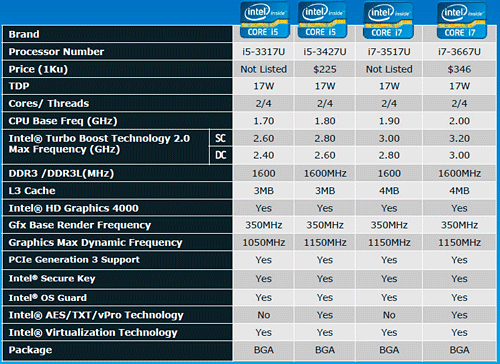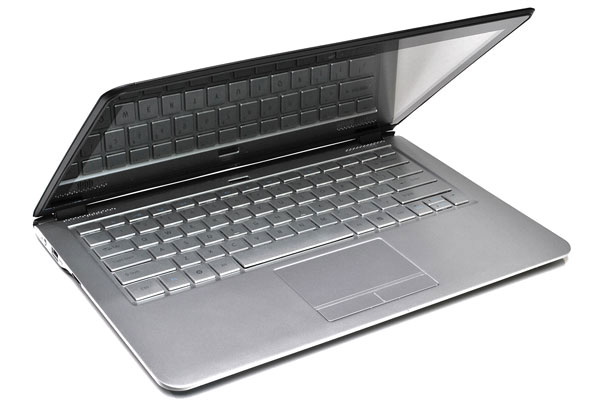Intel Core i5-3427U: Ivy Bridge For Ultrabooks
Introductions and Specifications
Today Intel is lifting the embargo veil off of a number of Core i5 Ivy Bridge processors for both the desktop and mobile segments. In terms of mobile products, Ultrabooks remain the clear focus for Intel, and as such, we've been setup with a demonstration vehicle for the new Core i5-3427U Ultra mobile processor that Intel is launching today, along with a few other SKUs for these super thin and light notebooks. Make sure to check out our coverage of the new 3rd generation Core i5 Ivy Bridge desktop processors here, but what follows is a look at Intel's latest Ultrabook vision and the shape of things to come in no-compromise, highly mobile computing according to Intel.
|
-
 1.8GHz Base Clock Speed
1.8GHz Base Clock Speed - 2.6GHz Max Turbo Boost Clock Speed
- 3MB Shared L3 Cache
- Intel HyperThreading - 2 cores/4 threads
- Intel HD4000 Graphics Processor Core
- 17W TDP, BGA package
- Intel 22nm Manufacturing Process Technology
2 Core and Four-Way Multi Task Processing: 4-way multi-task processing allows each core of the processor to work on two tasks at the same time.
Intel® Turbo Boost Technology 2.0: Dynamically increases the processor frequency up to 2.60GHz when applications demand more performance giving you speed when you need it, energy efficiency when you don’t.
Intel® Hyper-Threading Technology: 4 threads provide for better multi-tasking and threaded application processing.
Intel® Smart Cache: 3MB of L3 shared cache allows faster access to your data by enabling dynamic and efficient allocation of the cache to match the needs of each core, significantly reducing access latency to frequently used data and improving performance.
Integrated Memory Controller: Supports 2 channels of DDR3-1600 memory with 2 DIMMs per channel. Support for memory based on the Intel® Extreme Memory Profile (Intel® XMP) specification.
AES-NI: Provides 6 additional processor instructions that help to improve performance for AES encryption and decryption algorithms.
Chipset Compatibility: Compatible with all Intel® 7 Series Chipsets
Intel® Secure Key: a HW assist processor technology designed to produce high-quality, high-security, high-volume random numbers through an on-chip entropy source that can be used for various security computing demands, such as Intel’s own Identity Protection Technology, IPT.
Intel® Quick Sync Video 2.0 Technology: Media processing for fast conversion of video files for portable media players or online sharing, with transcode performance up to two times faster than standard voltage 2nd Gen Intel Core processors and up to 30 times faster than 3-year-old notebooks (Core™ 2 Duo).
Intel®InTru™3D: Stereoscopic 3D Blu-ray* playback experience in full HD 1080p resolution over HDMI 1.4 with 3D
Intel® Clear Video HD Technology: Visual quality and color fidelity enhancements for HD video playback and web browsing
Intel® HD Graphics 4000: A brand new graphics architecture delivering full DirectX 11 functionality and support for OpenGL version 3.3. Intel HD Graphics on 3rd generation core Ultra processors has similar graphics performance to dual core standard voltage 2nd Gen Intel Core processors.
Intel® Advanced Vector Extensions (Intel® AVX): Increased performance for demanding visual applications like professional video & image editing.

We've given you detail on both the Ivy Bridge core architecture and mobile architecture in our previous coverage last month, so we won't go into it in depth again here. We will, however, take a detailed look at what Intel has in store for their new "Chief River" Ultrabook, Centrino platform features as well as the prototype Ultrabook they sent us for testing.








